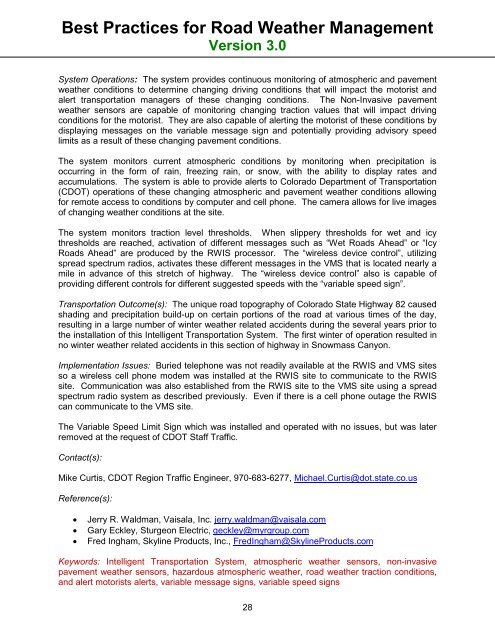Road Weather Management Program - FHWA Operations - U.S. ...
Road Weather Management Program - FHWA Operations - U.S. ...
Road Weather Management Program - FHWA Operations - U.S. ...
You also want an ePaper? Increase the reach of your titles
YUMPU automatically turns print PDFs into web optimized ePapers that Google loves.
Best Practices for <strong>Road</strong> <strong>Weather</strong> <strong>Management</strong>Version 3.0System <strong>Operations</strong>: The system provides continuous monitoring of atmospheric and pavementweather conditions to determine changing driving conditions that will impact the motorist andalert transportation managers of these changing conditions. The Non-Invasive pavementweather sensors are capable of monitoring changing traction values that will impact drivingconditions for the motorist. They are also capable of alerting the motorist of these conditions bydisplaying messages on the variable message sign and potentially providing advisory speedlimits as a result of these changing pavement conditions.The system monitors current atmospheric conditions by monitoring when precipitation isoccurring in the form of rain, freezing rain, or snow, with the ability to display rates andaccumulations. The system is able to provide alerts to Colorado Department of Transportation(CDOT) operations of these changing atmospheric and pavement weather conditions allowingfor remote access to conditions by computer and cell phone. The camera allows for live imagesof changing weather conditions at the site.The system monitors traction level thresholds. When slippery thresholds for wet and icythresholds are reached, activation of different messages such as “Wet <strong>Road</strong>s Ahead” or “Icy<strong>Road</strong>s Ahead” are produced by the RWIS processor. The “wireless device control”, utilizingspread spectrum radios, activates these different messages in the VMS that is located nearly amile in advance of this stretch of highway. The “wireless device control” also is capable ofproviding different controls for different suggested speeds with the “variable speed sign”.Transportation Outcome(s): The unique road topography of Colorado State Highway 82 causedshading and precipitation build-up on certain portions of the road at various times of the day,resulting in a large number of winter weather related accidents during the several years prior tothe installation of this Intelligent Transportation System. The first winter of operation resulted inno winter weather related accidents in this section of highway in Snowmass Canyon.Implementation Issues: Buried telephone was not readily available at the RWIS and VMS sitesso a wireless cell phone modem was installed at the RWIS site to communicate to the RWISsite. Communication was also established from the RWIS site to the VMS site using a spreadspectrum radio system as described previously. Even if there is a cell phone outage the RWIScan communicate to the VMS site.The Variable Speed Limit Sign which was installed and operated with no issues, but was laterremoved at the request of CDOT Staff Traffic.Contact(s):Mike Curtis, CDOT Region Traffic Engineer, 970-683-6277, Michael.Curtis@dot.state.co.usReference(s):• Jerry R. Waldman, Vaisala, Inc. jerry.waldman@vaisala.com• Gary Eckley, Sturgeon Electric, geckley@myrgroup.com• Fred Ingham, Skyline Products, Inc., FredIngham@SkylineProducts.comKeywords: Intelligent Transportation System, atmospheric weather sensors, non-invasivepavement weather sensors, hazardous atmospheric weather, road weather traction conditions,and alert motorists alerts, variable message signs, variable speed signs28
















